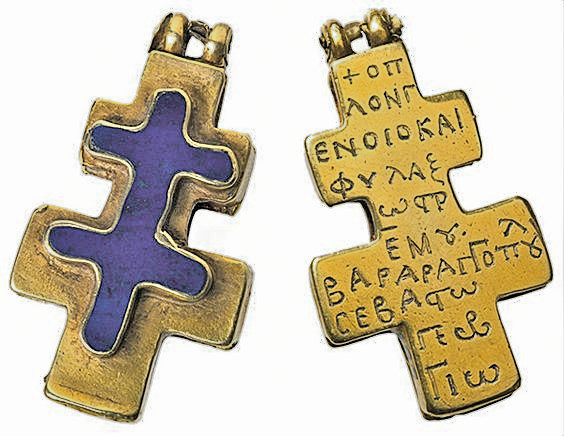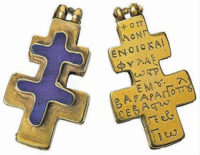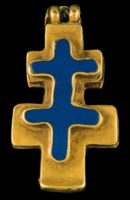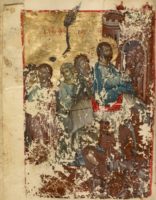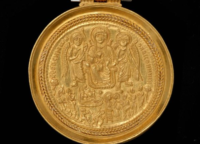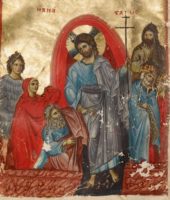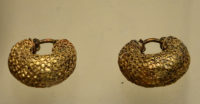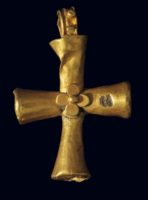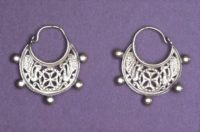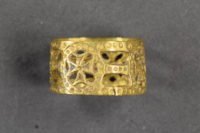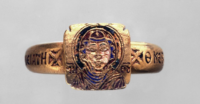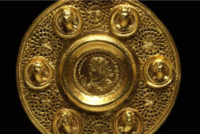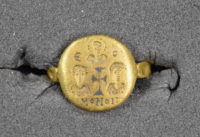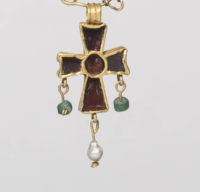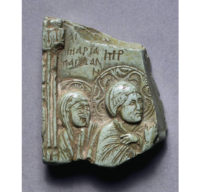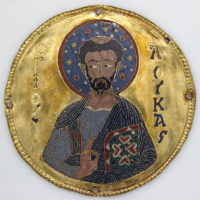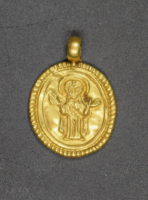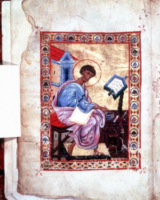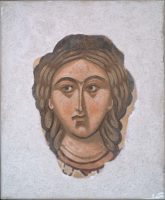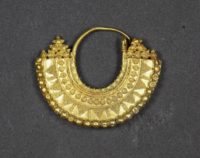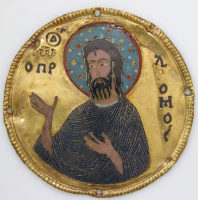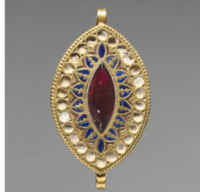Byzantine Pectoral Cross (front and back), Period: Late Byzantine circa: 1200–1400 A.D. , Benaki Museum, Athens. Museum Description: “Gold pectoral in the form of a Resurrection cross with double horizontal arms set with lapis lazuli. The owner’s name, Georgios Varagkopoulos, is inscribed on the back together with his title Sevastos (Augustus), which reflects his high social standing and explains the luxurious quality of the materials and the fine workmanship. “
The Benaki Museum of Greek Culture is housed in one of the most beautiful neoclassical-style buildings in Athens, near the National Garden and the Hellenic Parliament. It was converted into a museum in order to shelter the collections of Antonis Benakis and was donated to the Greek nation by himself and his three sisters, Alexandra, Penelope and Argine. Following its most recent refurbishment (1989–2000), the building houses a unique exhibition on Greek culture arranged diachronically from prehistory to the 20th century.
The Entry into Jerusalem, Period: Late Byzantince circa: 13 th century. Place (created): Nicaea (Modern Iznik, Turkey, Anatolia). Dimensions: Leaf: 20.6 × 14.9 cm (8 1/8 × 5 7/8 in.). Materials: Tempera colors and gold leaf on parchment. The J. Paul Getty Museum at the Getty Center in Los Angeles houses European paintings, drawings, sculpture, illuminated manuscripts, decorative arts, and photography from its beginnings to the present, gathered internationally.
Enkolpion with Enthroned Virgin, Nativity, Adoration and Baptism, Period: Early Byzantine, circa: Last quarter 6th century (ca. 583). Materials: gold. The museum is open to the public Tuesday through Sunday, 11:30 a.m.–5:30 p.m., except for federal holidays.
The Descent into Limbo, Period: Late Byzantine, circa: 13th century. Dimensions: Leaf: 20.6 × 14.9 cm (8 1/8 × 5 7/8 in.) Place: Nicaea, Modern Turkey (Place created).
Museum Description: “After his Crucifixion and before his Resurrection, Christ freed worthy Bible figures from limbo (an event known as the Anastasis in Greek). Here Christ pulls Adam by the wrist out of the tomb and toward the Kingdom of Heaven, while Abel, Eve, John the Baptist, King Solomon, and King David await their salvation. The two kings are dressed in the jeweled crowns and embroidered cloaks of Byzantine emperors.”
The collection of the J. Paul Getty Museum comprises Greek, Roman, and Etruscan art from the Neolithic to Late Antiquity; European art—including illuminated manuscripts, paintings, drawings, sculpture, and decorative arts—from the Middle Ages to the early twentieth century; and international photography from its inception to the present day.
Gold Earrings, Period: Early Byzantine, circa: 6th century A.D. Made in: Constantinople, Materials: Gold. In the Istanbul Archaeological Museum collections, there are rich and very important works of art belonging to various civilizations from the regions from Africa to Balkans , from Anatolia and Mesopotamia to Arab Peninsula and Afghanistan that were in the borders of the Ottoman Empire.
Cross, with a decorative quatrefoil rosette at the juncture of the arms. Materials: gold. Period: Early Byzantine; circa: Early 7th c. The Benaki Museum of Greek Culture is housed in one of the most beautiful neoclassical-style buildings in Athens, near the National Garden and the Hellenic Parliament.
[xyz-ihs snippet="Benaki-Hotels"]Pair of Loop Earrings; Materials: Gold. Period: Early Byzantine. 6thC-7thC. Subjects: Cross, Peacock. British Museum is closed 24, 25 and 26 December and 1 January, but is open every other day of the year. Fast facts about the British Museum: Founded: 1753, Collection size: 8 million objects, Oldest object in the collection: Stone chopping tool (nearly 2 million years old).
Gold Finger Ring; Early Byzantine. Period: 7thC – Early Byzantine. Excavated/Findspot: Smyrna (Asia, Turkey, Aegean Region, Anatolia (Turkey). British Museum is closed 24, 25 and 26 December and 1 January, but is open every other day of the year. Fast facts about the British Museum: Founded: 1753, Collection size: 8 million objects, Oldest object in the collection: Stone chopping tool (nearly 2 million years old).
Ring of Michael Attaleiates, Period: Middle Byzantine, Date: Before 1080. Materials: enamel on gold. The museum is open to the public Tuesday through Sunday, 11:30 a.m.–5:30 p.m., except for federal holidays.
Circular Pendant with Double Solidus of Constantine I, Period: Early Byzantine, Materials: gold. The museum is open to the public Tuesday through Sunday, 11:30 a.m.–5:30 p.m., except for federal holidays.
Gold Finger Ring; Early Byzantine. (6thc-7thc) Slender hoop and applied oval bezel engraved with male and female bust with nielloed cross between. Findspot: Beirut (Asia,Levant,Lebanon,Bayrut (governorate),Beirut) Above them is a bust of Christ. British Museum is closed 24, 25 and 26 December and 1 January, but is open every other day of the year. Fast facts about the British Museum: Founded: 1753, Collection size: 8 million objects, Oldest object in the collection: Stone chopping tool (nearly 2 million years old).
Chain with Pendant Cross, Materials: gold, glass, pearl, garnet, and sapphire. Period: Early Byzantine, circa 500s. The Cleveland Art Museum Hours: Tuesdays, Thursdays, Saturdays, Sundays 10:00 a.m.–5:00 p.m. Wednesdays, Fridays 10:00 a.m.–9:00 p.m. Closed Mondays.
Seal, John Tarchaneiotes, Period: Late Byzantine, 13 th. century. (second half). St. John the Baptist standing, holding a staff cross over his left shoulder. The museum is open to the public Tuesday through Sunday, 11:30 a.m.–5:30 p.m., except for federal holidays.
Fragment of an Icon of the Crucifixion with Mary Magdalen and the Virgin Mary. Material: Steatite. Period: 14th century, Late Byzantine. The Cleveland Art Museum Hours: Tuesdays, Thursdays, Saturdays, Sundays 10:00 a.m.–5:00 p.m. Wednesdays, Fridays 10:00 a.m.–9:00 p.m. Closed Mondays.
Medallion with Saint Luke from an Icon Frame, Period: Middle Byzantine, circa: ca. 1100, Made in Constantinople, Materials: Gold, silver, and enamel worked in cloisonné, Dimensions: Diam: 3 1/4 in. (8.3 cm) Mount: 20 1/2 x 15 x 7/8 in. (52.1 x 38.1 x 2.2 cm), On view at The Met Fifth Avenue in Gallery 303. The Metropolitan Museum of Art (New York) is one of the world’s largest and finest art museums. Its collection includes more than two million works of art spanning five thousand years of world culture, from prehistory to the present and from every part of the globe. Public Hours: 10:30 a.m.–5:30 p.m. Open seven days a week.
Gold Oval Pendant; embossed with a figure of the Virgin standing in the attitude of an orans within a pearled border. Findspot: Nile Delta, Alexandria, Egypt. Period: Early Byzantine. British Museum is closed 24, 25 and 26 December and 1 January, but is open every other day of the year. Fast facts about the British Museum: Founded: 1753, Collection size: 8 million objects, Oldest object in the collection: Stone chopping tool (nearly 2 million years old).
Gospels of Luke and John, Period:Middle Byzantine, circa: Late 12th-early 13th century A.D. The museum is open to the public Tuesday through Sunday, 11:30 a.m.–5:30 p.m., except for federal holidays.
Head of a Female Saint, Fresco transferred to panel, Period: Late Byzantine circa: 12th-14th centuries. The MFA is open 7 days a week. Monday and Tuesday 10 am–5 pm, Wednesday–Friday 10 am–10 pm, Saturday and Sunday 10 am–5 pm.
Gold Earring; semi-circular; with U-shaped loop to which is attached a similarly shaped thin plate of gold. Period: Middle Byzantine; 11thc.-12thc.; Found/Acquired: Syria. British Museum is closed 24, 25 and 26 December and 1 January, but is open every other day of the year.
Medallion with Saint John the Baptist from an Icon Frame, Period: Middle Byzantine, circa: 1100, Made in Constantinople, Materials: Gold, silver, and enamel worked in cloisonné. On view at The Met Fifth Avenue in Gallery 303. The Metropolitan Museum of Art (New York) is one of the world’s largest and finest art museums. Its collection includes more than two million works of art spanning five thousand years of world culture, from prehistory to the present and from every part of the globe. Public Hours: 10:30 a.m.–5:30 p.m. Open seven days a week.
Almond-Shaped Pendant, Period: Early Byzantine, circa: 400-600. Materials: gold, lapis lazuli, garnet, and glass. The Cleveland Art Museum Hours: Tuesdays, Thursdays, Saturdays, Sundays 10:00 a.m.–5:00 p.m. Wednesdays, Fridays 10:00 a.m.–9:00 p.m. Closed Mondays.


